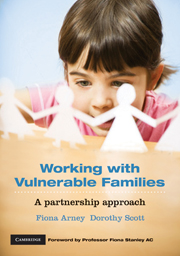Book contents
- Frontmatter
- Foreword
- Contents
- List of figures, tables and boxes
- Contributors
- Acknowledgements
- Introduction
- Chapter 1 Think child, think family, think community
- Chapter 2 Family strengths: an international perspective
- Chapter 3 Harnessing ‘resilience’ when working with children and families
- Chapter 4 Working within and between organisations
- Chapter 5 Family-centred practice in early childhood settings
- Chapter 6 Sustained nurse home visiting with families of Aboriginal children
- Chapter 7 Including fathers in work with vulnerable families
- Chapter 8 Parenting in a new culture: working with refugee families
- Chapter 9 Responding to parents with complex needs who are involved with statutory child protection services
- Chapter 10 Engaging family members in decision making in child welfare contexts
- Chapter 11 Supporting parents whose children are in out-of-home care
- Chapter 12 Using evidence-informed practice to support vulnerable families
- Chapter 13 Spreading promising ideas and innovations in child and family services
- Index
Chapter 12 - Using evidence-informed practice to support vulnerable families
- Frontmatter
- Foreword
- Contents
- List of figures, tables and boxes
- Contributors
- Acknowledgements
- Introduction
- Chapter 1 Think child, think family, think community
- Chapter 2 Family strengths: an international perspective
- Chapter 3 Harnessing ‘resilience’ when working with children and families
- Chapter 4 Working within and between organisations
- Chapter 5 Family-centred practice in early childhood settings
- Chapter 6 Sustained nurse home visiting with families of Aboriginal children
- Chapter 7 Including fathers in work with vulnerable families
- Chapter 8 Parenting in a new culture: working with refugee families
- Chapter 9 Responding to parents with complex needs who are involved with statutory child protection services
- Chapter 10 Engaging family members in decision making in child welfare contexts
- Chapter 11 Supporting parents whose children are in out-of-home care
- Chapter 12 Using evidence-informed practice to support vulnerable families
- Chapter 13 Spreading promising ideas and innovations in child and family services
- Index
Summary
Learning goals
This chapter will enable you to:
Recognise the role that research can play in improving the lives of vulnerable families and their children
Be aware of contemporary views of research-informed child and family welfare practice
Understand how research is used by policy makers and practitioners and what factors influence their use of research
Understand the types of knowledge that are important in decision making for policy and practice, and
Think about how you might use research to inform your practice with vulnerable families and their children.
Introduction
Those who are enamored of practice without science are like a pilot who goes into a ship without rudder or compass and never has any certainty where he is going.
(Leonardo da Vinci, 1452–1519)The National Framework for Protecting Australia's Children 2009–2020 identifies ‘supporting a national research agenda’ as an action for the first three years of its implementation in order to support the improvement of and consistency in child protection services (Commonwealth of Australia, 2009, p. 27). A high quality evidence base has the potential to inform decision making in policy and practice (Bromfield & Arney, 2008). It can play an important role in the development and delivery of interventions (Lochman, 2006). It can also assist in screening children and families who are in need of services; provide frameworks and models for intervention; aid in assessing, refining and maximising the effectiveness of interventions; and help to identify why programs do and don't work (Lochman, 2006).
- Type
- Chapter
- Information
- Working with Vulnerable FamiliesA Partnership Approach, pp. 247 - 274Publisher: Cambridge University PressPrint publication year: 2010

